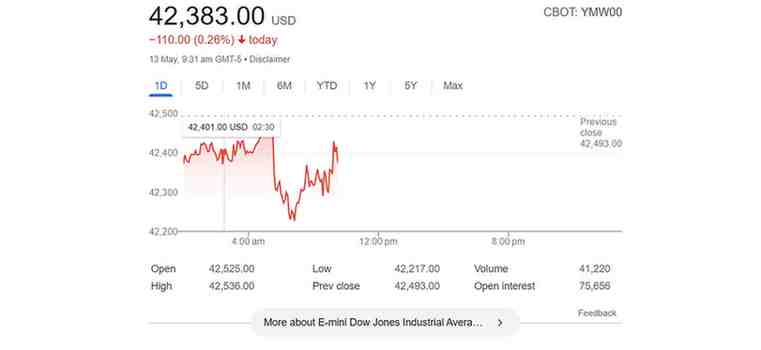What Are Dow Jones Futures?
Dow Jones futures are financial contracts that speculate on the future value of the Dow Jones Industrial Average (DJIA). These futures allow investors to anticipate and hedge market movements even before the stock market opens. Tracks the performance of about 30 large, publicly traded companies.
In simpler terms, Dow Futures give you a sneak peek into how the stock market might behave at the start of the trading day. If futures are up, the market may open higher. If they’re down, a bearish start could be expected.
Why Dow Futures Matter to U.S. Investors
Dow Jones Futures are more than just numbers on a screen. Here’s why they are crucial:
- Market Sentiment Gauge: They reflect investor sentiment during off-market hours.
- Pre-Market Strategy Tool: Traders use them to adjust positions before regular trading hours.
- Global Impact: Overseas events and global economic data often move Dow Futures first.
- Economic Indicator: Futures react to macroeconomic data, Fed decisions, inflation reports, and geopolitical tensions.
When Do Dow Futures Trade?
Dow Jones Futures are traded almost 24 hours a day, five days a week, mainly on the Chicago Mercantile Exchange (CME).
Here’s the typical schedule (Eastern Time):
- Sunday to Friday: Opens at 6:00 PM and trades overnight
- Daily Break: 5:00 PM to 6:00 PM (1-hour pause)
This extended schedule lets investors react to after-hours events and global news that occur outside Wall Street’s 9:30 AM to 4:00 PM schedule.

How Are Dow Futures Used in Trading?
Here are a few popular ways traders and investors use Dow Futures:
- Hedging: Investors hedge their long-term positions to protect against potential losses.
- Speculation: Day traders use futures to profit from short-term market moves.
- Portfolio Strategy: Portfolio managers monitor futures for rebalancing and risk management.
Latest Trends in Dow Futures (As of May 2025)
As of this week, Dow Jones Futures are experiencing volatility due to multiple factors:
- Interest Rate Uncertainty: With the Fed still undecided on rate cuts in 2025, traders remain cautious.
- Earnings Season: Major companies like Apple, JPMorgan, and Walmart have released mixed Q1 earnings.
- Geopolitical Tensions: Ongoing issues in the Middle East and Asia are causing safe-haven buying and market jitters.
- Inflation Data: April CPI numbers show a slight decline in inflation, sparking optimism among bulls.
As of early trading today, Dow Futures are up 120 points, indicating a positive start for the U.S. markets.
Tips for Trading Dow Futures
- Watch Global Markets: Asian and European markets often influence Dow Futures.
- Use Stop-Loss Orders: Futures are leveraged products; manage risk carefully.
- Follow the Fed: Interest rate decisions greatly affect market direction.
- Study Technical Charts: Dow Futures react quickly to support/resistance levels.
Key Terms to Know
- DJIA: Dow Jones Industrial Average, a benchmark index of 30 top U.S. companies.
- CME: Chicago Mercantile Exchange, where Dow Futures are traded.
- Tick Size: The minimum price movement of a futures contract.
- Margin: The minimum amount required to trade future
Conclusion: Why You Should Watch Dow Futures Daily
Dow Jones futures aren’t just for Wall Street professionals – they’re an essential tool for anyone serious about investing. Whether you’re a day trader, swing trader or long-term investor, keeping an eye on Dow futures helps you stay one step ahead of the market. And if you want to invest in them, do your research first, because news can sometimes deceive you.
So next time you wake up early, check the Dow Futures before the opening bell—it might just change your entire trading plan for the day!

